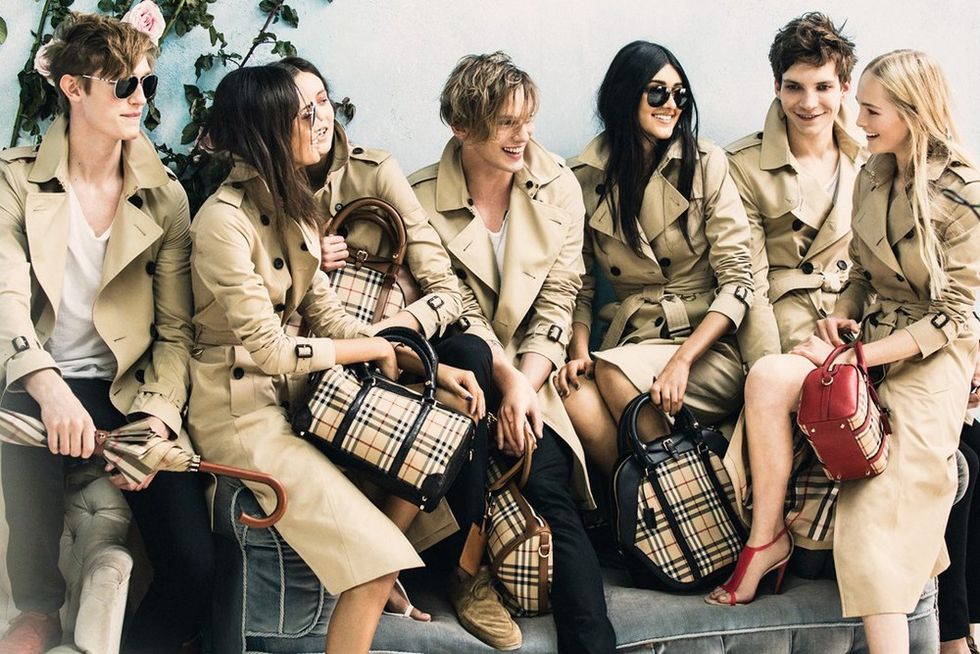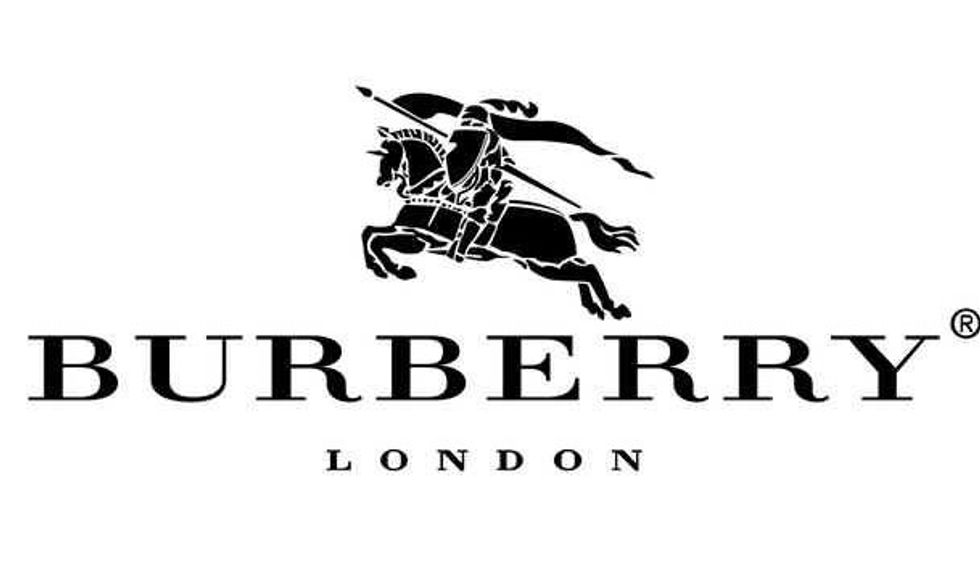Burberry was founded in 1856 by an English draper’s apprentice named Thomas Burberry. Thomas was 21 years old when he founded the company and his first products were focused around outdoor attire. Today, the company is extremely successful and a leader in luxury fashion. Comparable luxury brands and competitors are Louis Vuitton, Ralph Lauren, and Gucci. Since it’s creation, Burberry’s product lines have extended beyond men’s and women’s outdoor clothing to children’s wear and beauty products. There’s now an extensive product line which includes items such as handbags, shoes, eyewear, makeup, accessories, and attire.
Burberry mostly targets millennials with high disposable income, but they have a unique marketing strategy which appeals to everyone (GlobalData, 2016). The target age range is approximately 25-35, but the products also appeal to older consumers because the products are generally classic styles (GlobalData, 2016). The children’s line targets young families in the upper social class as well. The company used to be mostly for men, but today, women are the largest group targeted because they’re more likely to purchase the children’s and beauty products as well as women’s attire.
Burberry is quite expensive and considered a luxury brand, but they make some items, specifically fragrances, accessible to the average consumer (GlobalData, 2016). This is great for marketing because it allows Burberry to be “exclusive” with their high price products, keeps an elite brand image, and targets consumers in each price point with certain products. Burberry’s products range from approximately $30 - $7,000; their popular trench coat is usually over $1,000. Beauty products and fragrances are on the lower end, while trench coats and handbags are the more pricy products.
Burberry is present in several regions which includes the Americas, Europe, Middle East, Asia Pacific, India, and Africa (GlobalData, 2016). The Asia Pacific is their largest market which accounts for 37% of their total retail revenue (GlobalData, 2016). The Americas are responsible for 27% of total retail sales, and everything else combined is responsible for 36% of sales (GlobalData, 2016). Burberry reported £2.5 billion for 2015/2016 revenues (GlobalData, 2016). Accessories are the highest selling products, followed by women’s wear, men’s wear, then beauty products. The children’s line accounted for less than 4% of sales (GlobalData, 2016).
Burberry’s marketing strategy changed dramatically once they started targeting millennials. Before, especially in the 50’s and 60’s, Burberry mostly targeted rich celebrities, but then realized the market potential for high-spending young people (Davis, 2014). Today, millennials have an increasing level of disposable income (likely because people save less money), but they are more complex to market to because of their rapidly changing environment (Davis, 2014). Burberry realized that millennials are mostly influenced by their peers and don’t care about what a fashion house has to say (Davis, 2014). If they see their friends or peers in Burberry, that’s the best (and free) marketing that the company can get. Millennials can be extremely brand loyal, and Burberry offers programs such as “Burberry Acoustic” which features up and coming British artists (Davis, 2014). This appeals to millennials because it’s something they can relate to. The “underground” and “cool” bands are then correlated with Burberry furthermore increasing the brand image.
Burberry has increased its appeal to millennials by integrating a seamless online and in-store experience (Davis, 2014). Whether the user is shopping digitally or physically, they still get a unique, personal experience which forms consistency and loyalty (Davis, 2014). The market is going online to shop and desires the integrated online experience. According to the Marketing Week article (2016), mobile conversion has increased by 40%, and Burberry’s social media now has over 40 million followers. Burberry has gone digital in-stores by including products with RFID tags which will launch a video about the item’s craftsmanship when the item is picked up by a customer (Davis, 2014). If a customer goes in a dressing room to try something on, the RFID tag will trigger a video of a model on a runway wearing that product (Davis, 2014). The video gives styling ideas and may create further purchases if the consumer likes the model’s outfit. I interviewed two regular consumers of Burberry and asked why the brand appealed to them. Lauren, 28, said she loved shopping in their stores and consistently received excellent customer service. She stated that the stores were clean and extremely organized which she appreciated. Lauren also said she desired the high status and symbolism of wearing Burberry. Tyler, 22, also said he loved the customer experience when he shopped in stores. He said the clerks may have an air of snobbiness, but once they realize you are a serious customer, they are knowledgable and helpful.
Some strengths of Burberry are their diverse product offerings and increase in capital (GlobalData, 2016). They have been working to lower the costs of their production, and therefore increased profit and worth by acquiring more efficient capital. Burberry is also present in several countries and has been around long enough to have an extremely solid foundation and brand image (GlobalData, 2016). Their final strength is their seamless integration of brick and mortar and online stores. The brand remains the same whether a customer is buying online, in a department store, or at an exclusive Burberry store (GlobalData, 2016).
A weakness of Burberry is their high operating cost (GlobalData, 2016). They have been working over the past few years to move around production facilities to cheaper areas while still creating high-quality products (GlobalData, 2016). For instance, they have shut down a coat factory in New Jersey, USA and moved it overseas to places like Germany and Italy (GlobalData, 2016). Their operating costs may decrease, but Burberry will no longer be able to mark those coats “Made in America”, which could potentially hurt their American market.
An opportunity for Burberry is their increasing market potential in the Asia Pacific region. According to the LexisNexis article, “Retail sales volume in Asia Pacific [could] reach $11.8 trillion [by] 2020; followed by North America with $4.4 trillion.” Burberry is mainly looking to China and India to be their growing markets in the future (GlobalData, 2016). India recently changed its policies to include up to 51% foreign investment in retailing, so Burberry can look to expand their business there (GlobalData, 2016). Another opportunity is the growing e-commerce market and Burberry already has established presence in this area (GlobalData, 2016). With the growth of e-commerce, Burberry’s market share can increase, while saving on operational costs of brick and mortar stores.
A prevalent threat facing the entire industry is the fast and ever-changing fashion (GlobalData, 2016). Now, most products have a short life-cycle, and people don’t want to pay a lot for something that will be obsolete within a couple of weeks. Pricing pressure is also stemming from the abnormal changes in weather and unpredictability of the climate (GlobalData, 2016). Winter items may be harder to sell because of global warming. Burberry may have to change their trench coats to lighter versions or reduce production of their coats if the warm-weather trend keeps occurring. Burberry also competes heavily with other luxury brands mentioned earlier (GlobalData, 2016). Each brand is fiercely competitive and if a consumer is not loyal to Burberry, they will buy whatever appeals to them the most. The last threat is counterfeit products (GlobalData, 2016). The counterfeit market is increasing, and some producers are able to create extremely similar items so consumers can tell little difference between that and the real thing (GlobalData, 2016). If someone can get the same item at a reduced cost, they will buy that, especially if they lack brand loyalty. As counterfeit items become more abundant, it can also tarnish Burberry’s image if someone believes it is an authentic item and it’s low-quality (GlobalData, 2016).
Burberry can continue to be a major player in the fashion game if they continue to do what they’re doing and take advantage of their opportunities. They must adapt and be quick to change as the market and consumers grow more complex. Burberry is already doing an excellent job of taking advantage of the online market and appealing to upper-class millennials. They can continue to grow and become a lifestyle brand as long as they keep millennials loyal and focused on the right things.
References
(August 25, 2016). GlobalData - SWOT Analysis, Retrieved from www.lexisnexis.com/hottopics/lnacademic
Davis, S. (2014, March 27). Burberry's Blurred Lines: The Integrated Customer Experience. Retrieved September 17, 2016, from http://www.forbes.com/sites/scottdavis/2014/03/27/burberrys-blurred-lines-the-integrated-customer-experience/#2330adb222fc
Hobbs, T. (2016, May 18). Burberry admits its customer loyalty is 'lagging' and marketing needs 'rebalancing' Retrieved September 17, 2016, from https://www.marketingweek.com/2016/05/18/burberry-admits-customer-loyalty-is-lagging-and-marketing-needs-rebalancing-as-profits-fall-10/




















